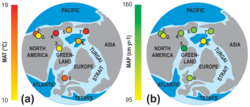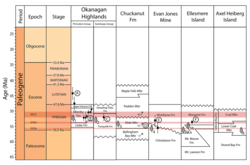Margaret Formation
| Margaret Formation Stratigraphic range: Wasatchian | |
|---|---|
| Type | Formation |
| Unit of | Eureka Sound Group |
| Overlies | |
| Thickness | 140 m (460 ft) |
| Lithology | |
| Primary | Sandstone |
| Other | Siltstone, coal, tuff |
| Location | |
| Coordinates | 78°42′N 81°54′W / 78.7°N 81.9°WCoordinates: 78°42′N 81°54′W / 78.7°N 81.9°W |
| Approximate paleocoordinates | 76°06′N 30°42′W / 76.1°N 30.7°W |
| Region | Ellesmere Island, Northwest Territories, Nunavut |
| Country | |
| Extent | |
 Margaret Formation (Canada) | |
The Margaret Formation is a geologic formation of the Eureka Sound Group in the in Northwest Territories and Nunavut, Canada. The unit belonging to the Eureka Sound Group which crops out at Ellesmere Island preserves fossils dating back to the Early Eocene period, or Wasatchian in the NALMA classification.[1]
The Margaret Formation comprises sandstones, sandy siltstones, clay-rich sandstones, coal seams and clay-rich coal seams and volcanic ash beds. The thickness of the formation, which overlies the , reaches about 140 metres (460 ft). Radiometric dating of the formation provided ages of 52.6 ± 1.9 Ma (2010) and 53.7 ± 0.6 Ma (2017).
The area where the formation was deposited in the Early Eocene experienced a much warmer climate than the High Arctic today, with mean annual temperatures ranging from 7.6 to 12.9 °C (45.7 to 55.2 °F) and warmest month mean temperatures from 18.2 to 22.2 °C (64.8 to 72.0 °F). The deltaic to swamp environment of the Margaret Formation has provided a diverse fauna of various groups of mammals, birds (Presbyornis and Gastornis), reptiles (turtles, snakes, lizards and crocodiles) and fish.
Description[]
The Margaret Formation comprises sandstones, sandy siltstones, clay-rich sandstones, coal seams and clay-rich coal seams and volcanic ash beds. The thickness of the formation, which overlies the , reaches about 140 metres (460 ft).[2]
The formation was probably deposited in a lush proximal to environment, with abundant channels and coal swamps.[3]
Dating[]
A volcanic ash layer containing crandallite in the middle of the formation was dated using U-Pb radiometric dating in 2017 to 53.7 ± 0.6 Ma.[2] In 2010, ashes of the formation were dated to 52.6 ± 1.9 Ma.[4]
Arctic climate of the Early Eocene[]

During the Early Eocene, the climate of much of northern North America was warm and wet, with mean annual temperatures (MAT) as high as 20 °C (68 °F), mean annual precipitation (MAP) of 100 to 150 centimetres (39 to 59 in), mild frost-free winters (coldest month mean temperature >5 °C (41 °F)), and climatic conditions that supported extensive temperate forest ecosystems.[5]
Ensemble estimates of mean annual temperatures for the high-latitude fossil localities in Arctic Canada ranged from 7.6 to 12.9 °C (45.7 to 55.2 °F), with the range of coldest month mean temperature from 1.3 to 4.2 °C (34.3 to 39.6 °F) and warmest month mean temperatures from 18.2 to 22.2 °C (64.8 to 72.0 °F). Mean annual precipitation estimates for the Margaret Formation ranged between 131 and 180 centimetres (52 and 71 in).[6] The mean summer precipitation has been estimated at 1,134 millimetres (44.6 in) and mean winter precipitation at 366 millimetres (14.4 in).[7]
The fossils and sedimentology indicate a lush, rain forest community on a coastal delta plain. Multiple palaeoclimate proxies, ranging from oxygen isotope analysis of vertebrate bones and teeth to palaeofloral analyses, estimate a mild temperate climate for the Eocene High Arctic, where winters remained at or just above freezing and summer temperatures extended to 20 °C (68 °F) or higher. These temperatures are a far cry from today's High Arctic, where central Ellesmere Island experiences a mean annual temperature of −19 °C (−2 °F), a warm month mean temperature of about 6 °C (43 °F) and a cold month mean temperature of −38 °C (−36 °F) or colder.[8]
Despite the mild Eocene Arctic climate, the vertebrate fauna would have experienced months of total darkness and cooler temperatures during the winter. Recent isotopic work suggests that some mammals, including the hippo-like Coryphodon, were year-round residents in the High Arctic. Given that Gastornis was large (approaching 2 metres (6.6 ft)) and flightless, it likely also was a year-round resident of the Arctic. In contrast, the volant Presbyornis might have been a seasonal migrant to the Arctic.[8]
Fossil content[]





The formation has provided the following fossils:[1]
Mammals[]
- Primates
- Acreodi
- Carnivora
- Dermoptera
- Eutheria
- Ferae
- Glires
- Hyaenodonta
- Leptictida
- Multituberculata
- Pantodonta
- Perissodactyla
Birds[]
- Anseriformes
- Gastornithiformes
Reptiles[]
- Turtles
- Crocodiles
- Lizards
- Snakes
- Erycidae indet.[21]
Amphibians[]
- Caudata
Fish[]
- Teleostei
- Amiiformes
- Lepisosteiformes
Correlations[]

The formation has been correlated with the Allenby Formation and of British Columbia, the Chickaloon Formation of Alaska,[24] and with the , Chuckanut and .[25] The upper Margaret Formation also has been correlated with the Buchanan Lake Formation of the Eastern Arctic Archipelago.[26]
| Formation | Wasatch | DeBeque | Claron | Indian Meadows | Pass Peak | Tatman | Willwood | Golden Valley | Coldwater | Allenby | Margaret | Nanjemoy | Hatchetigbee | Tetas de Cabra | Hannold Hill | Coalmont | Cuchara | Galisteo | San Jose | Ypresian (IUCS) • Itaboraian (SALMA) Bumbanian (ALMA) • Mangaorapan (NZ) | ||
|---|---|---|---|---|---|---|---|---|---|---|---|---|---|---|---|---|---|---|---|---|---|---|
| Basin | Powder River Uinta Piceance Colorado Plateau Wind River Green River Bighorn |
Piceance |
Colorado Plateau |
Wind River |
Green River |
Bighorn |
Williston | Okanagan | Rio Grande | North Park | Raton | Galisteo | San Juan | |||||||||
| Country | ||||||||||||||||||||||
| Copelemur | ||||||||||||||||||||||
| Coryphodon | ||||||||||||||||||||||
| Diacodexis | ||||||||||||||||||||||
| Homogalax | ||||||||||||||||||||||
| Oxyaena | ||||||||||||||||||||||
| Paramys | ||||||||||||||||||||||
| Primates | ||||||||||||||||||||||
| Birds | ||||||||||||||||||||||
| Reptiles | ||||||||||||||||||||||
| Fish | ||||||||||||||||||||||
| Insects | ||||||||||||||||||||||
| Flora | ||||||||||||||||||||||
| Environments | Alluvial-fluvio-lacustrine | Fluvial | Fluvial | Fluvio-lacustrine | Fluvial | Lacustrine | Fluvio-lacustrine | Deltaic-paludal | Shallow marine | Fluvial | Shallow marine | Fluvial | Fluvial | |||||||||
| Volcanic | Yes | No | Yes | No | Yes | No | Yes | No | Yes | No | ||||||||||||
See also[]
- List of fossiliferous stratigraphic units in Northwest Territories
- List of fossiliferous stratigraphic units in Nunavut
References[]
- ^ a b Margaret Formation at Fossilworks.org
- ^ a b Sudermann, 2017
- ^ Bay Fiord at Fossilworks.org
- ^ Reinhardt et al., 2010, p.2
- ^ West et al., 2020, p.1387
- ^ West et al., 2020, p.1394
- ^ Schubert et al., 2012, p.525
- ^ a b Stidham & Eberle, 2016, p.5
- ^ a b c West et al., 1977
- ^ a b c d Eberle & McKenna, 2002
- ^ a b c Eberle, 2001
- ^ Rose et al., 2004
- ^ McKenna, 1980
- ^ a b c d e Dawson, 2001
- ^ Dawson, 1990
- ^ a b Beard & Dawson, 2014
- ^ a b Alroy, 2002
- ^ Dawson, 2012
- ^ Eberle, 2005
- ^ a b Stidham & Eberle, 2016, p.3
- ^ a b c d e f g h i j k l Estes & Hutchison, 1980
- ^ Alroy, 2006
- ^ Gardner, 2012
- ^ West et al., 2020, p.1390
- ^ West et al., 2020, p.1391
- ^ Eberle & Greenwood, 2012, p.6
Bibliography[]
- Geology and climate
- ; ; ; ; , and . 2020. Paleobotanical proxies for early Eocene climates and ecosystems in northern North America from middle to high latitudes. Climate of the Past 16. 1387–1410. Accessed 2020-09-05.
- ; ; ; , and . 2017. A palynological investigation of the Arctic late Paleocene–early Eocene Margaret Formation at Stenkul Fiord, Ellesmere Island, NU, Canada, 1. Climate and Biotic Events of the Paleogene (CBEP 2017). Accessed 2020-09-05.
- , and . 2012. Life at the top of the greenhouse Eocene world — A review of the Eocene flora and vertebrate fauna from Canada's High Arctic. GSA Bulletin 124. 3–23.
- ; ; ; , and . 2012. A summertime rainy season in the Arctic forests of the Eocene. Geology 40. 523–526.
- ; ; ; , and . 2010. Altered volcanic ashes in Paleocene/Eocene Eureka Sound Group sediments (Ellesmere Island, Arctic Canada) – new stratigraphic tie-points?, 1–2. GeoCanada 2010 – Working with the Earth.
- Paleontology
- , and . 2016. The palaeobiology of high latitude birds from the early Eocene greenhouse of Ellesmere Island, Arctic Canada. Scientific Reports 6. 1–8. Accessed 2020-09-05.
- , and . 2014. Northernmost Global Record for Multituberculata from the Eocene of Ellesmere Island, Arctic Canada. Journal of Vertebrate Paleontology 34. 1476–1480.
- . 2012. Coryphodon, the northernmost Holarctic Paleogene pantodont (Mammalia), and its global wanderings. Swiss Journal of Palaeontology 131. 11–22.
- . 2012. Revision of Piceoerpeton MESZOELY (Caudata: Scapherpetontidae) and description of a new species from the late Maastrichtian and ? early Paleocene of western North America. Bulletin de la Société Géologique de France 183. 611–620.
- . 2006. Synonymies and reidentifications of North American fossil vertebrates, .. _.
- . 2005. A new 'tapir' from Ellesmere Island, Arctic Canada - Implications for northern high latitude palaeobiogeography and tapir palaeobiology. Palaeogeography, Palaeoclimatology, Palaeoecology 227. 311–322.
- ; , and . 2004. Arcticanodon dawsonae, a primitive new palaeanodont from the lower Eocene of Ellesmere Island, Canadian High Arctic. Canadian Journal of Earth Sciences 41. 757–763.
- , and . 2002. Early Eocene Leptictida, Pantolesta, Creodonta, Carnivora, and Mesonychidae (Mammalia) from the Eureka Sound Group, Ellesmere Island, Nunavut. Canadian Journal of Earth Sciences 39. 899–910.
- . 2001. Early Eocene rodents (Mammalia) from the Eureka Sound Group of Ellesmere Island, Canada. Canadian Journal of Earth Sciences 38. 1107–1116. Accessed 2020-09-05.
- . 2001. Early Eocene Leptictida, Pantolesta, Creodonta, Carnivora, and Cete from Ellesmere Island--Arctic Links to Europe and Asia. Journal of Vertebrate Paleontology 21. 46A.
- . 1990. Canada's Missing Dimension, .. _.
- , and . 1980. Eocene lower vertebrates from Ellesmere Island, Canadian Arctic Archipelago. Palaeogeography, Palaeoclimatology, Palaeoecology 30. 325–347.
- . 1980. Eocene paleolatitude, climate, and mammals of Ellesmere Island. Palaeogeography, Palaeoclimatology, Palaeoecology 30. 349–362.
- ; , and . 1977. Fossils from the Paleogene Eureka Sound Formation, N.W.T., Canada; occurrence, climatic and paleogeographic implications. In West, R. M. (ed), Paleontology and plate tectonics with special reference to the history of the Atlantic Ocean. 2. 77–93.
- Geologic formations of Canada
- Eocene Series of North America
- Paleogene Northwest Territories
- Paleogene Nunavut
- Ypresian Stage
- Wasatchian
- Sandstone formations of Canada
- Siltstone formations
- Coal formations
- Coal in Canada
- Tuff formations
- Deltaic deposits
- Paludal deposits
- Fossiliferous stratigraphic units of North America
- Paleontology in the Northwest Territories
- Paleontology in Nunavut
- Ellesmere Island


